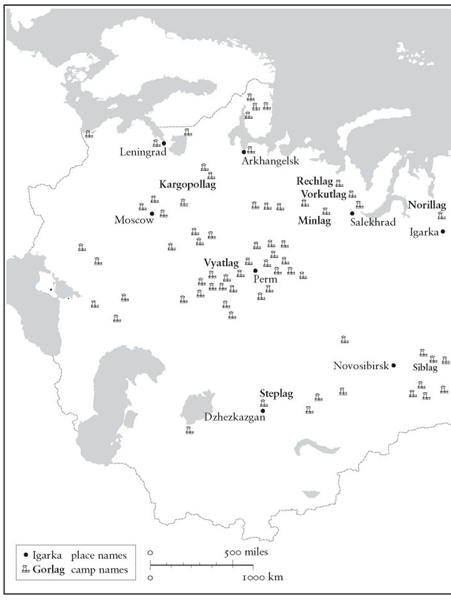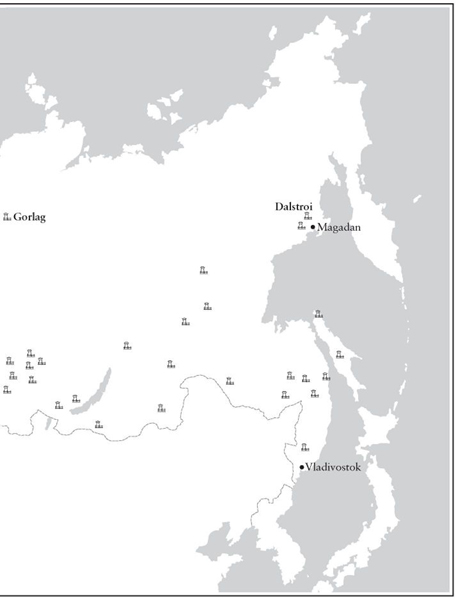Gulag (21 page)



The Gulag at its zenith, 1939–1953
PART TWO
LIFE AND WORK IN THE CAMPS
Chapter 7
ARREST

We never asked, on hearing about the latest arrest, “What was
he arrested for?” but we were exceptional. Most people,
crazed by fear, asked this question just to give themselves a
little hope; if others were arrested for some reason, then they
wouldn’t be arrested, because they hadn’t done anything
wrong. They vied with each other in thinking up ingenious
reasons to justify each arrest: “Well, she really is a smuggler,
you know,” “He really did go rather far,” or “It was only to be
expected, he’s a terrible man,” “I always thought there was
something fishy about him,” “He isn’t one of us at all . . .”
This was why we had outlawed the question “What was
he arrested for?”
“What for?” Akhmatova would cry indignantly
whenever, infected by the prevailing climate, anyone of our
circle asked this question.
“What do you mean what for? It’s time you understood
that people are arrested for nothing!”
—Nadezhda Mandelstam Hope Against Hope
1
ANNA AKHMATOVA—the poet, quoted above by another poet’s widow—was both right and wrong. On the one hand, from the middle of the 1920s—by the time the machinery of the Soviet repressive system was in place—the Soviet government no longer picked people up off the streets and threw them in jail without giving any reason or explanation: there were arrests, investigations, trials, and sentences. On the other hand, the “crimes” for which people were arrested, tried, and sentenced were nonsensical, and the procedures by which people were investigated and convicted were absurd, even surreal.
In retrospect, this is one of the unique aspects of the Soviet camp system: its inmates arrived, most of the time, via a legal system, if not always the ordinary judicial system. No one tried and sentenced the Jews in Nazi-occupied Europe, but the vast majority of inmates in Soviet camps had been interrogated (however cursorily), tried (however farcically), and found guilty (even if it took less than a minute). Undoubtedly, the conviction that they were acting within the law was part of what motivated those working within the security services, as well as the guards and administrators who later controlled the prisoners’ lives in the camps.
But I repeat: the fact that the repressive system was legal does not mean that it was logical. On the contrary, it was no easier to predict with any certainty who would be arrested in 1947 than it had been in 1917. True, it became possible to guess who was
likely
to be arrested. During waves of terror in particular, the regime appears to have chosen its victims in part because they had for some reason come to the attention of the secret police—a neighbor had heard them tell an unfortunate joke, a boss had seen them engaging in “suspicious” behavior—and in larger part because they belonged to whichever population category was at that moment under suspicion.
Some of these categories were relatively specific—engineers and specialists in the late 1920s, kulaks in 1931, Poles or Balts in occupied territories during the Second World War—and some were very vague indeed. Throughout the 1930s and 1940s, for example, “foreigners” were always considered suspect. By “foreigners,” I mean people who actually were citizens of other countries, people who might have contacts abroad, or people who might have some link, imaginery or real, to a foreign country. No matter what they did they were always candidates for arrest—and foreigners who stood out in any way, for any reason, stood a particularly high chance. Robert Robinson, one of several black American communists who moved to Moscow in the 1930s, later wrote that “Every single black I knew in the early 1930s who became a Soviet citizen disappeared from Moscow within seven years.”
2
Diplomats were not exempt. Alexander Dolgun, for example, an American citizen and a junior employee of the American Embassy in Moscow, describes in his memoirs how he was picked up off the street in 1948 and accused, unjustly, of spying; suspicion fell upon him partly because of his youthful fondness for evading the “tails” that the secret police set on him, and because he was skilled in persuading embassy chauffeurs to lend him cars, leading the Soviet secret police to suspect that he might be more important than his rank would indicate. He spent eight years in camps, returning to the United States only in 1971.
Foreign communists were frequently targets. In February 1937, Stalin ominously told Georgi Dmitrov, General Secretary of the Communist International—the Comintern, the organization dedicated to the fomenting of world revolution—that “all of you there in the Comintern are working in the hands of the enemy.” Of the 394 members of the Executive Committee of the Communist International in January 1936, only 171 remained in April 1938. The rest had been shot or sent to camps, among them people of many nationalities: German, Austrian, Yugoslav, Italian, Bulgarian, Finnish, Baltic, even English and French. Jews appear to have suffered disproportionately. In the end, Stalin killed more members of the pre-1933 German Communist Party Politburo than did Hitler: of the sixty-eight German communist leaders who fled to the Soviet Union after the Nazi seizure of power, forty-one died, by execution or in camps. The Polish Communist Party may have been even more thoroughly decimated. According to one estimate, 5,000 Polish communists were executed in the spring and summer of 1937.
3
But it was not necessary to be a member of a foreign communist party: Stalin also targeted foreign fellow travelers, of whom the 25,000 “American Finns” were probably the most numerous. These were Finnish-speaking Finns, some had emigrated to America, some had been born there, all of whom came to the Soviet Union during the 1930s, the years of the Great Depression in the United States. Most were factory workers, and most had been unemployed in the United States. Encouraged by Soviet propaganda—Soviet recruiters traveled around Finnish-speaking communities in the United States, speaking of the wonderful living conditions and work opportunities in the USSR—they flocked to the Finnish-speaking Karelian Republic. Almost immediately, they caused problems for the authorities. Karelia was not, it turned out, much like America. Many loudly pointed this out to anyone who would listen, then tried to return—and wound up in the Gulag in the late 1930s instead.
4
Soviet citizens with foreign connections were no less suspect. First in line were the “diaspora nationalities,” the Poles, Germans, and Karelian Finns who had relatives and contacts across the border, as well as the Balts, Greeks, Iranians, Koreans, Afghans, Chinese, and Romanians scattered across the USSR. According to their own archives, between July 1937 and November 1938, the NKVD convicted 335,513 people in these “national” operations.
5
Similar operations would be repeated during and after the war, as we shall see.
But it was not even necessary to speak a foreign language in order to come under suspicion. Anyone with a foreign connection was suspected of spying: stamp collectors, Esperanto enthusiasts, anyone with a pen pal or with relatives abroad. The NKVD also arrested all Soviet citizens who had worked on the Chinese Eastern Railway, a railway line across Manchuria whose origins dated from the Czarist era, and accused them of having spied for Japan. In the camps, they were known as the “Kharbintsy,” after the city of Harbin, where many had lived.
6
Robert Conquest describes the arrests of an opera singer who had danced with the Japanese ambassador at an official ball, and of a veterinarian who attended to dogs belonging to foreigners.
7
By the late 1930s, most ordinary Soviet citizens had worked out the pattern, and wanted no foreign contacts at all. Karlo Stajner, a Croatian communist with a Russian wife, remembered that “Russians only rarely dared to have private dealings with foreigners . . . My wife’s relatives remained virtual strangers to me. None of them dared visit us. When her relatives learned of our plan to marry, Sonya was warned by all of them ...”
8
Even as late as the mid-1980s—when I first visited the Soviet Union—many Russians remained wary of foreigners, ignoring them or refusing to make eye contact with them on the street.
And yet—not every foreigner was picked up by the police, and not everyone accused of having foreign connections actually did have foreign connections. It also happened that people were picked up for far more idiosyncratic reasons.
9
As a result, asking the question “What for?”—the question Anna Akhmatova so disliked—produces a truly astonishing range of ostensible explanations.
Nadezhda Mandelstam’s husband, Osip Mandelstam, for example, was arrested for his poetic attack on Stalin:
We live, not feeling the land beneath us
We speak, and ten steps away no one hears us
But where there’s even a whispered conversation
The Kremlin’s mountaineer, murderer, and peasant-slayer will be mentioned.
His fat fingers, like grubs, are greasy
His words, like lead weights, are final
His cockroach moustache sneers
His boot rims shine
And all around him, a gaggle of spineless leaders,
Half-humans, serve as his toys
One whinnies, one purrs, one whines
Only he shouts and points
Throwing decrees like horseshoes
Hitting a groin, a head, an eye—
Every death sentence tastes sweet
For the broad-chested Ossete
10
Although different reasons were officially stated, Tatyana Okunevsksaya, one of the Soviet Union’s best-loved film actresses, was arrested, she believed, for refusing to sleep with Viktor Abakumov, the wartime head of Soviet counter-intelligence. To make sure she understood that this was the true reason, she was (she claims) shown an arrest warrant with his signature on it.
11
The four Starostin brothers, all of them outstanding soccer players, were arrested in 1942. They always believed it was because their team, Spartak, had the misfortune to defeat Lavrenty Beria’s favorite team, Dynamo, a touch too decisively.
12
But it was not even necessary to be extraordinary. Lyudmila Khachatryan was arrested for marrying a foreigner, a Yugoslav soldier. Lev Razgon recounted the story of a peasant, Seryogin, who, on being told that someone had killed Kirov, replied, “Damned if I care.” Seryogin had never heard of Kirov, and assumed he was someone who had died in a fight in the neighboring village. For that mistake, he received a ten-year sentence.
13
By 1939, telling a joke, or hearing one, about Stalin; being late for work; having the misfortune to be named by a terrified friend or a jealous neighbor as a “co-conspirator” in a nonexistent plot; owning four cows in a village where most people owned one; stealing a pair of shoes; being a cousin of Stalin’s wife; stealing a pen and some paper from one’s office in order to give them to a schoolchild who had none; all of these could, under the right circumstances, lead to a sentence in a Soviet concentration camp. Relatives of a person who had illegally tried to cross the Soviet border were liable to arrest, according to a 1940 law, whether or not they had known about the attempted escape.
14
Wartime laws—on being late to work and forbidding job changes—would add more “criminals” to the camps as well, as we shall see.
If the reasons for arrest were many and varied, so too were the methods. Some prisoners had ample warning. For several weeks prior to his arrest in the mid-1930s, an OGPU agent repeatedly called Alexander Weissberg in for questioning, asking him over and over again how he had come to be a “spy”: Who recruited you? Whom did you recruit? What foreign organization are you working for? “He put exactly the same questions over and over again, and I always gave him the same answers.”
15
At about the same time, Galina Serebryakova, the author of
The Young
Marx
and the wife of a high functionary, was also “invited” every evening to Lubyanka, kept waiting until two or three o’clock in the morning, interrogated, released at five in the morning, and returned to her apartment. Agents surrounded her building and a black car followed her when she went outside. So convinced was she of her coming arrest that she tried to kill herself. Nevertheless, she endured several months of this sort of harassment before actually being arrested.
16
During heavy waves of mass arrest—of kulaks in 1929 and 1930, of Party activists in 1937 and 1938, of former prisoners in 1948—many knew their turn was coming simply because all those around them were being arrested. Elinor Lipper, a Dutch communist who had come to Moscow in the 1930s, was living in 1937 in the Hotel Lux, a special hotel for foreign revolutionaries: “every night a few more persons vanished from the hotel . . . in the morning, there would be large red seals pasted on the doors of a few more rooms.”
17
In times of real terror, some even experienced the arrest itself as a sort of relief. Nikolai Starostin, one of the unlucky soccer stars, was trailed by agents for several weeks, and became so annoyed that he finally went up to one of them and demanded an explanation: “If you want something from me, call me into your office.” As a result, at the moment of arrest he felt not “shock and fear” but “curiosity.”
18




